


SHAI LANGEN
Jo Goes Hunting – Run Away
Amsterdam material designer Shai Langen made sculptural headpieces and covered models in hand-painted patterns for Jo Goes Hunting’s Run Away music video.Langen was approached by the Dutch artist’s manager with a brief for “something less conventional”, and was given complete artistic freedom in his approach.The video opens with a close up of a gleaming paint-covered black and white surface, which is gradually shown to be the form of a person.
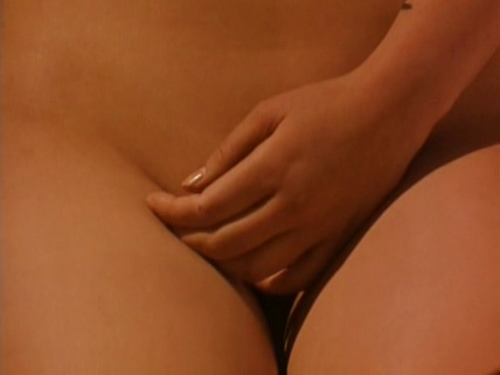
PETER GREENAWAY
بيتر غريناواي
彼得·格林纳威
פיטר גרינווי
ピーター·グリーナウェイ
피터 그리너웨이
Питер Гринуэй
The Pillow Book
Beautiful to behold and impossible to forget, THE PILLOW BOOK is auteur Peter Greenaway’s erotically-charged drama about love, death, revenge and the indelible nature of our earliest memories. Each year on her birthday, Nagiko (Vivian Wu) would became her father’s canvas, as he painted the creation myth in elaborate, elegant calligraphy on her body. Years later, she continues the practice with a succession of lovers, including a bisexual translator (Ewan McGregor) who becomes a pawn in an escalating game of vengeance against her beloved father’s exploitative publisher. Told in a series of chapters and featuring innovative cinematography and picture-in-picture techniques, Roger Ebert called THE PILLOW BOOK “a seductive and elegant story [that] stands outside the ordinary.”
cinema full

JOANIE LEMERCIER
EYJAFJALLAJÖKULL
Inspired by the icelandic volcano, which wreaked travel havoc across europe, Joanie Lemercier presents the latest incarnation of its audiovisual mapping project painted directly onto a large wall, a wireframed scenery is slowly revealed by gentle light effects. The audience’s sense are progressively challenged as optical illusions question their perception of space.

Robert Breer
Float
The Floats – or floating sculptures – that Robert Breer took up producing again at the end of the 1990s, emerged in 1965. The word “float” meaning something floating – a marker, fishing float or buoy – and which also describes those carnival vehicles whose pretend wheels give them the appearance of floating above the tarmac, enabled Robert Breer to apply this principle to works of a new genre. Primary shapes, neutral colours and, for the most recent, an industrial aspect, the Floats were then made with polystyrene, foam, painted plywood, and, more latterly, out of fibreglass. At first glance, these simple structures appear immobile. In fact, they are moving, imperceptibly, within the space they inhabit. Motorised and on mini-rollers – which raise them slightly above ground, giving them an air of weightlessness – they glide unbeknown to the visitor, following random paths that are interrupted by the slightest obstacle that they encounter.
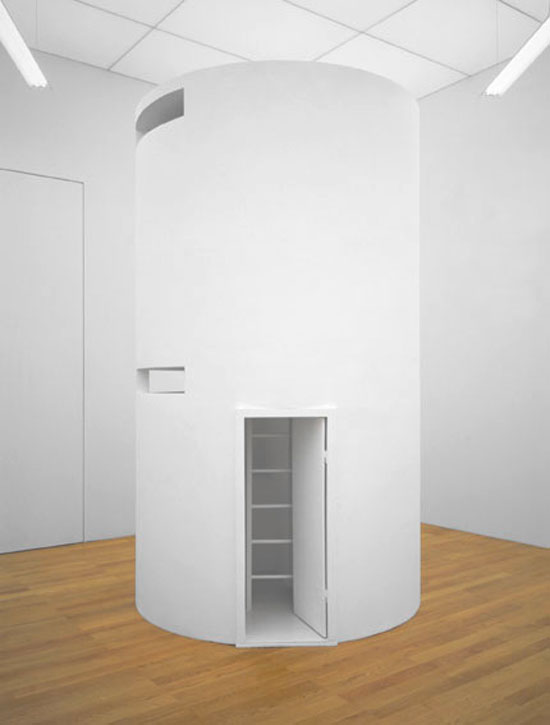
ABSALON
cellule No. 5
Absalon’s best known works, the Cellules, rewrite Cezanne’s “treat nature as the cylinder, the sphere and the cone” to read “treat architecture as the cell, the bunker and the turret.” Not that the Cellules are straightforwardly architecture: they equally evoke Minimalist sculpture, Matt Mullican’s maquettes, Kurt Schwitters’ Merzbauen and the Concrete sculptures of George Vantongerloo. But the model that the Cellules most overtly evoke is the monastic cell. The Cellules were fabricated in wood, cardboard and plaster, and painted entirely white; their average proportions are roughly those of a caravan, and the catalogue informs us that there is always an area in which one can stand up. Their interiors are fitted–fitted rather than furnished–with unobtrusive minimal representations of desks, seats, beds, etc.

Mat Collishaw
The mask of youth
The eyes of the latest portrait of Queen Elizabeth I follow you around the room. No, they really do. Mat Collishaw’s hyperrealistic mask of the Tudor queen comes to life, whirring and grimacing, to shock visitors in the shadowy former royal chambers of the Queen’s House. As the days darken, the effect will get spookier. The Virgin Queen’s dark eyes dart around nervously. Her mouth opens as if to speak but she cannot find the words. She is dazed by a future she can’t comprehend, a robot ghost staring in horror and doubt at her own painted image – Collishaw’s undead death mask has her eyes fixed on the Armada Portrait, painted in 1588 and a treasure of the Queen’s House after being meticulously restored.

Matt Roberts
Dazzle Camouflage
Dazzle Camouflage is a mode of camouflage that uses confusion rather than concealment as its method. Developed in the early 20th century, Dazzle Camouflage was often added to naval ships, which were painted to feature perplexing black and white patterns. In these uncertain times with access to immense amounts of information and when terms such as fake news, deep fakes, alternative facts are becoming part of our lexicon, we often find that the true meaning of our inquiries as with all our desires is concealed by confusion. To participate a user can enter a search word or hashtag to search Twitter. The frequency of the word on Twitter is used to generate black and white patterns. The software will continue to search for the word on twitter and create more complex patterns as the frequency of the word increases.

SANKAI JUKU
山海塾
butoh
TOBARI
“Over the 90 minute performance, I feel no less than transported. There are eight male performers, including Ushio Amagatsu himself. The dancers often move slowly, with incredible muscular control, fluidity and elegance. And suddenly the spell will be broken and they’ll run across the stage, their painted bodies leaving clouds of white powder hanging in the air like a shadow or ghost. Slow sustained movements are countered with tiny, minute gestures of the fingers. Hands are often gnarled, the joints contorted with incredible tension. It is mysterious, hypnotic and strange. The countenance of the performers is most arresting – behind the white paint, their faces reveal the fragility, humility, vulnerability and truth of their humanity.”Day Helesic

James Whitaker
Joshua Tree Residence
Whitaker has envisioned an “exoskeleton” made of shipping containers painted bright white. The containers appear like a starburst, with cuboid forms pushing out in all directions.The home is intended to offer a connection to the sun-baked landscape, while concurrently providing a sense of protection and privacy. Square windows frame views of the blue sky and rugged terrain. In some areas, faceted ceilings give the effect of being inside a crystalline form.

Greg Dunn
brain art
To capture their strikingly chaotic and spontaneous forms, the neurons in Self Reflected are painted using a technique wherein ink is blown around on a canvas using jets of air. The resulting ink splatters naturally form fractal like neural patterns, and although the artist learns to control the general boundaries of the technique it remains at its heart a chaotic, abstract expressionist process.

NANINE LINNING
BACON
He painted the abysses of the human soul: the British artist Francis Bacon. Basic mechanisms of relationships such as desire, domination and exclusion he presented with merciless honesty and painful beauty.
With her piece, Nanine Linning fathoms the emotional cosmos of Bacon`s paintings and detects in their uncompromising depiction an analogy with her own art. With excessive physicality, the choreography explores fundamental patterns of behavior, which blur the line between human and feral bearing by their archaic and merciless nature. From an almost disturbing proximity the spectator witnesses the struggle of the individual for affiliation.At the same time fascinating and disturbing, the piece celebrates its comeback on stage fourteen years after its first release. BACON, which received the »Swan« for the best Dutch choreography, returns with revised choreography and new video- and light design.

Sterling Ruby
ACTS/ALPHA BLOCKER
In ACTS—short for “Absolute Contempt for Total Serenity”—Ruby captures liquid dye inside clear urethane and balances these pure prisms atop scuffed, inscribed, and spray-painted Formica bases. These works expand upon his earlier Formica sculptures such as Big Grid/DB Deth (2008), a scratched-up monolith that exudes a cold, prisonlike institutional menace. In ACTS, the juxtaposition of unfeeling laminate slabs against vibrantly pigmented urethane is a potent one; it transforms the urethane from a passive, glassy vitrine into an active agent of incarceration that suffocates the blossoming furls of dye.

JOSÉ LEÓN CERRILLO
Doble agente
The Mexican artist José León Cerrillo, born in 1976 in San Luís Potosí, uses his multifaceted oeuvre to question what exactly makes a painted picture a work of art. Cerrillo examines the discursive function and the “social character” of painting by provocatively paring a picture down to a decorative pattern or by experimenting with the many different ways of presenting a picture.
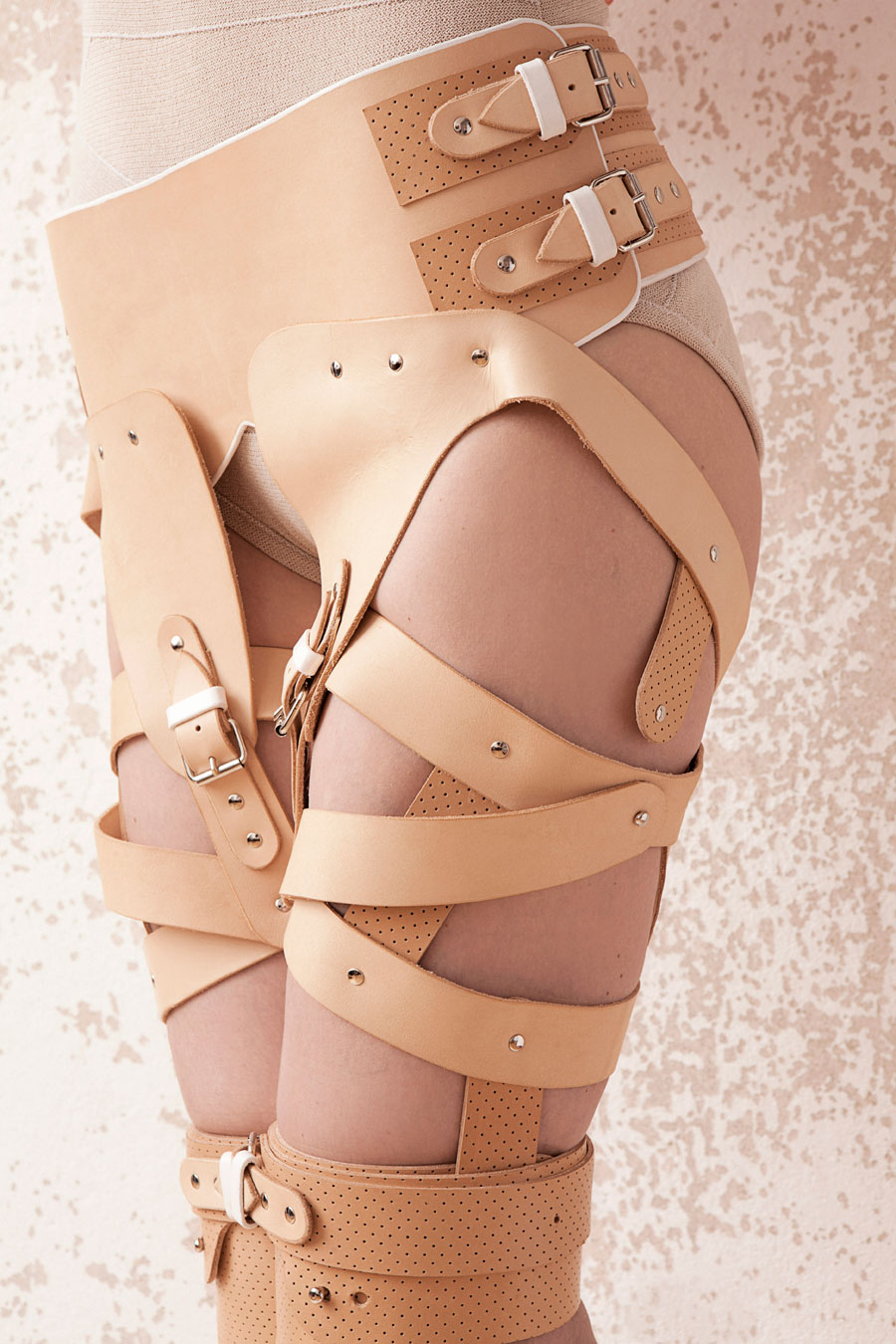
MARINA HOERMANSEDER
[…]Her first collection reflects her inspirational playground of sculpturing leather by moulding it to the body, twisting buckles, leather straps creating volume, a fabric made out of medical bandages and all over ruffled silk. This fashion statement comes along with a high level of quality and handcraft. A lot of the pieces are fully studded by hand and profoundly processed. The vegetably tanned leather is hand painted and one dress consists out of more than 100 meters auf silk strips. By adding accessories such as leather headpieces and armcuffs, she balances a striking inspiration to a high level of contemporary fashion.
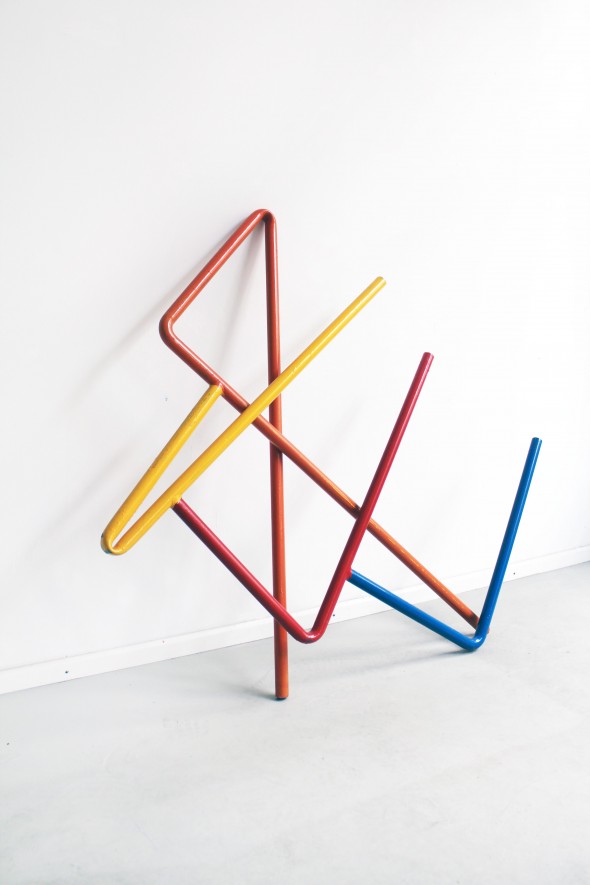
Przemek Pyszczek
Playground Structure (Steps)
In his recent channels of work, Przemek Pyszczek has painted with concrete and ripped apart playgrounds. As hardcore as this sounds, his bright studio in Schöneweide features friendly knots of primary-colored pipes resting in one corner, and opposite, a canvas with waves of sherbet hues leans against the wall. Pyszczek’s use of a variety of aesthetics and materials is the outcome of his recent focus on the contemporary urban landscape of Poland, where he was born.

awol erizku
My new sculpture oh what a feeling
Distressed by the lack of representation for people of color in art history and museums and galleries, Awol Erizku aims to rectify this omission in his photographs, sculptures, and video installations, which are centered upon subjects of color. In his words, “There are not that many colored people in the galleries that I went to [growing up] or the museums that I went to. I was just like, when I become an artist I have to put my two cents in this world.” He does this in a critically acclaimed series of photographic portraits, re-crafting famous painted portraits by artists like Vermeer and Caravaggio by replacing their white subjects with contemporary black ones. By re-staging these and other iconic works of art, Erizku engages in critical discourse with the past, cracking open the canon with historically repressed voices.

José León Cerrillo
The Mexican artist José León Cerrillo, born in 1976 in San Luís Potosí, uses his multifaceted oeuvre to question what exactly makes a painted picture a work of art. Cerrillo examines the discursive function and the “social character” of painting by provocatively paring a picture down to a decorative pattern or by experimenting with the many different ways of presenting a picture.

Willy Verginer
ВИЛЛИ ВЕРДЖНЕРА
意大利雕塑家
ciuria de foies
These lifelike sculptures are typically carved from solid linden wood then painted with acrylic paint. Their subtle but strange gestures coupled with unexpected objects give the sculptures a quietly surreal atmosphere. Verginer’s peculiar style of painting his work adds to each piece’s enigmatic quality. Rather than realistically paint each individual detail, Verginer applies large swaths of color to his sculptures. The pieces nearly seem to be dipped in pools of pigment. These large fields of color work in contrasting against the realism of each sculpture.

Melanie Bonajo
梅拉妮·柏娜桥
Nocturnal Gardening
Photographs of painted people, tinted by sunlight flooding in through colorful tissue paper, are interspersed with delicate ferns and towering bamboo sticks. A lithium drone within the gallery’s white walls is broken up by Night Soil – Fake Paradise, an experimental documentary film by Melanie Bonajo in which women from Brooklyn candidly discussion their deeply personal experiences with ayahuasca. Some of the revelations are blissful and mystic while others turn completely horrifying, melting the psyche down into utterly submissive goo — Bonajo’s way of reminding us of the immeasurable power of psychedelic substances.
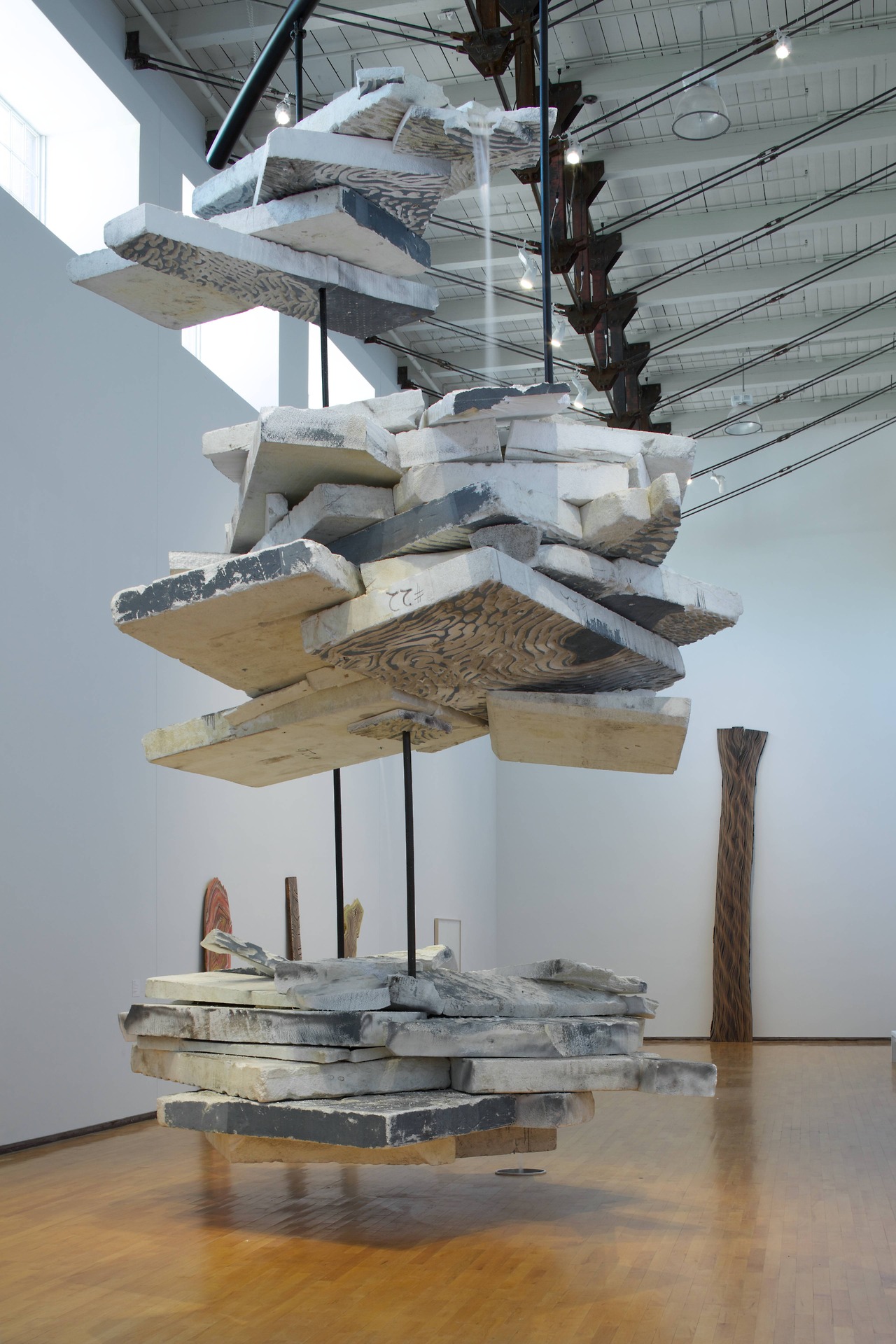
Jason Middlebrook
Джейсон Миддлбрук
Falling Water
[…] Middlebrook’s work consistently references art-historical traditions, styles, and movements. For instance, his sculptures crafted from hardwood planks, which he began in 2008 after relocating from New York City to Hudson, New York, feature painted abstractions. They are collisions of nature, art-making, and history that exemplify the artist’s approach.
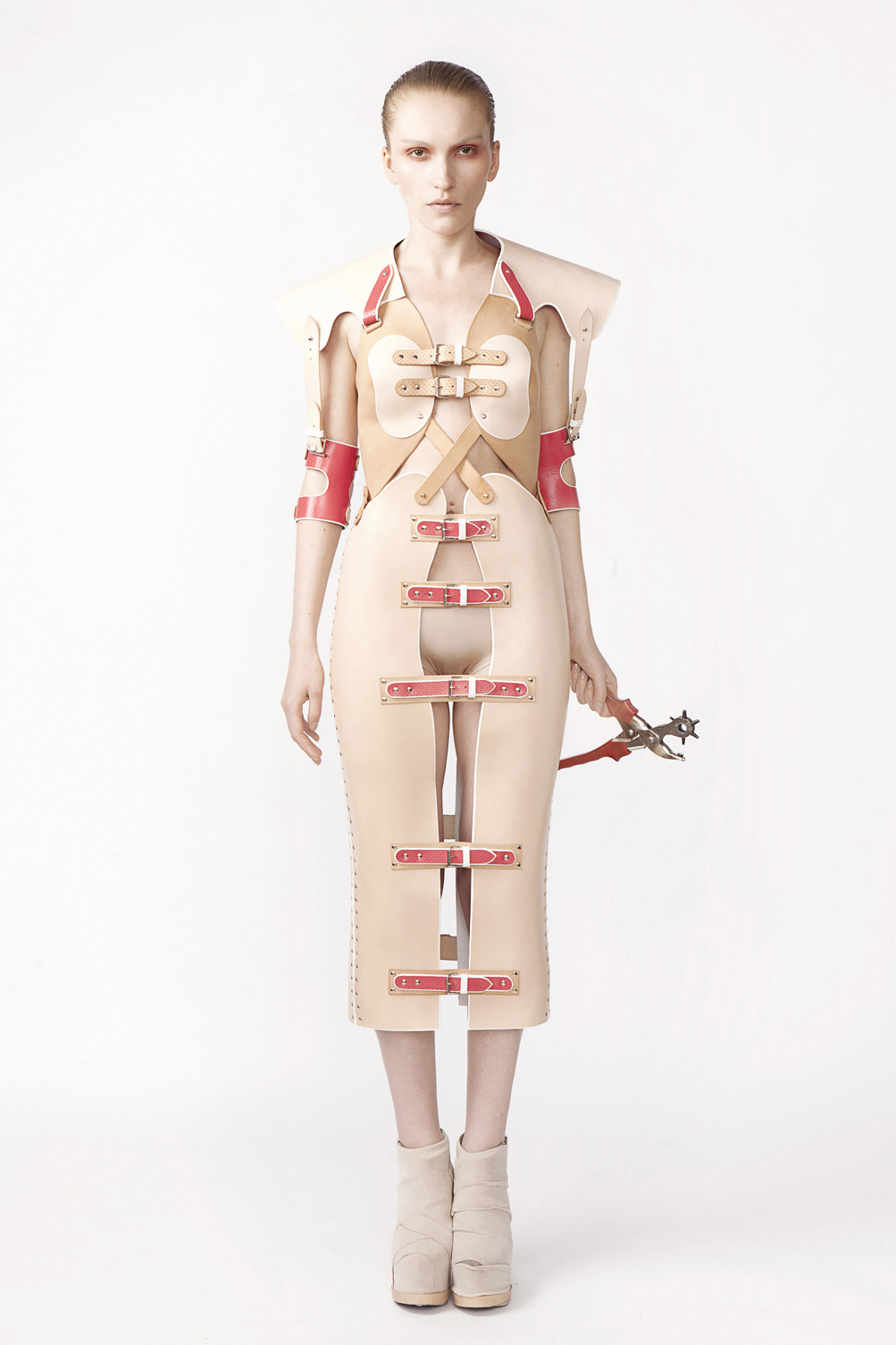
MARINA HOERMANSEDER
Marina Hoermanseder developed her art throughout her time at Esmod Berlin International University of Art and mastered her handcraft at Alexander McQueen.”I go wherever my creativity takes me” says Austrian fashion designer Marina Hoermanseder. For her diploma collection she therefore did not hesitate to use discomforting inspirations such as orthopaedic devices and serious skin conditions. Vegetable-tanned leather is double-sided and painted red on the reverse to create patterns where sections are flipped over.

SØLVE SUNDSBØ
noomi rapace
Solve Sundsbo is a Norwegian fashion photographer who cleverly manipulates images making them out of the ordinary.
His work incorporates everything from X-rays and 3-D scanning to hi-tech manipulation and laborious hand-painted retouching. “If I’ve got a style,” says Sundsbo, “it’s that I’ve got no style.”

ALEXA MEADE
Алексе Мид
human portrait (paintings with real Humans)
Rather than creating representational paintings on a flat canvas, Alexa Meade creates her representational paintings directly on top of the physical subjects that she is referencing. When photographed, the representational painting and the subject being referenced appear to be one and the same as the 3D space of her painted scenes becomes optically compressed into a 2D plane.

ERIK JOHANSSON
إريك جوهانسون
에릭 요한슨
אריק ג’והנסון
エリックヨハンソン
Arms break, vases don’t
Erik Johannson is a self-taught photograher who learned how to retouch photos to make impossible and extraordinary images. Growing up with a grandmother who painted and a penchant for escaping into the other worlds of video games, he naturally blended the two into a technique using computers to generate images that couldn’t be captured by a camera.

christine lew
Galactic Everyday
The subject of humanness and achieving human comfort in space has been overlooked by science. Humanizing space needs to be addressed and given attention and research in order for humans to live well in long-term space colonization and deep space exploration. My position on space travel is neither the picture painted by NASA and SPACEX, nor is it the adventures of Barbarella, it is the grey area of space, the overlooked day-to-day life of humanity that I believe to be of importance. Why can’t living in space be purposeful and fulfilling but also enjoyable, pleasurable, and sensuous?
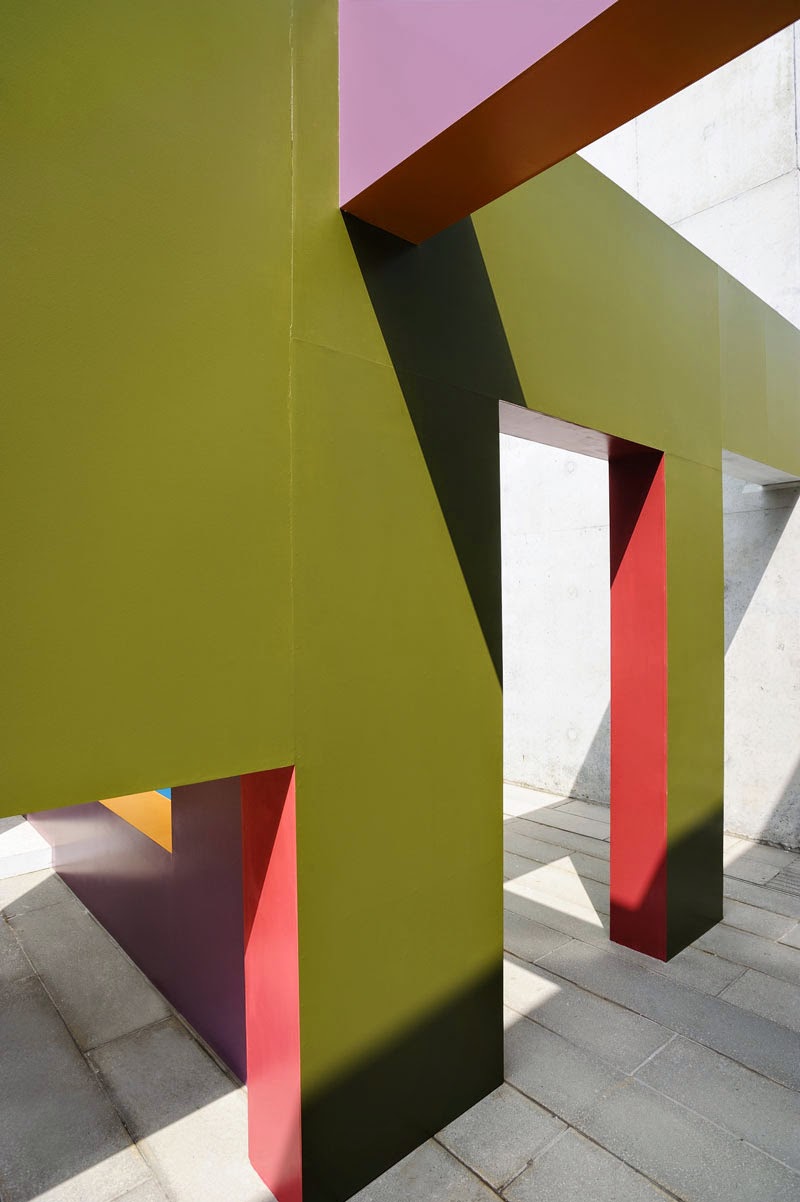
KRIJN DE KONING
laberinto cromatico
Dutch artist Krijn de Koning has created a labyrinthine walkway between brightly coloured walls on a terrace at the Turner Contemporary gallery in Margate, England.
The first public commission in England by De Koning, the Dwelling installation comprises a series of angled walls punctured with doorways and windows that create a trail for visitors to navigate through.Situated on the south terrace of the David Chipperfield-designed Turner Contemporary, the walls are positioned between the exterior of the gallery building and the site boundary.The elements slot between existing structures, incorporating changes in floor level and abutting permanent concrete balustrades.“The artist’s site-specific works – part architecture, part sculpture – challenge the viewer, offering new possibilities to navigate and experience the space the works inhabit,” said a statement from the gallery.Perpendicular surfaces, including door and window recesses, are all painted in different colours.The bright tones reference traditional seaside pavilions and beach huts, a common feature along the UK coast.The maze is open to the sky so shadows move across the surfaces of installation through the day.Architectural features including windows and doors are different sizes and positioned at various heights, allowing some to be clambered over or crawled beneath.
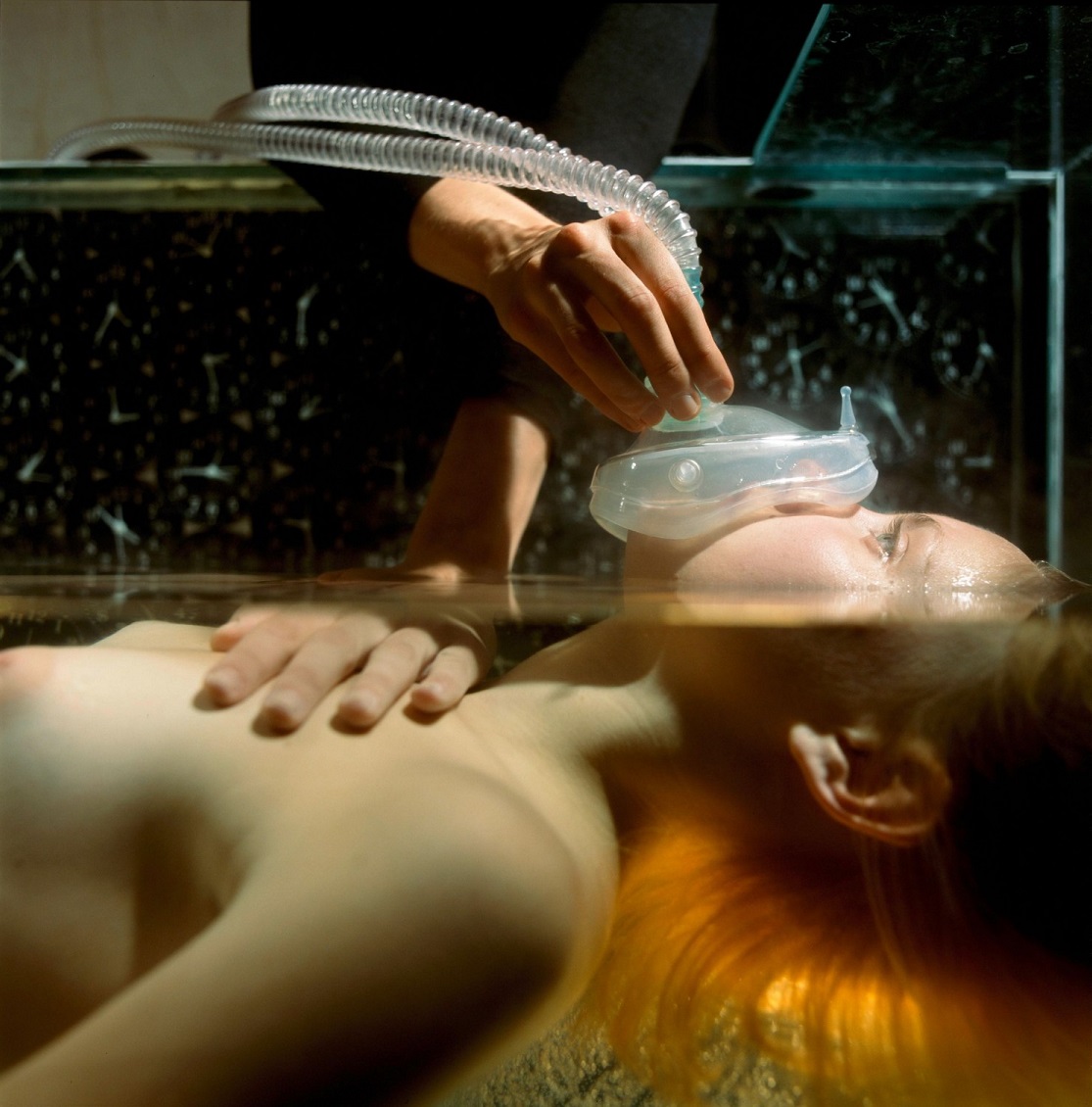
REYNOLD REYNOLDS
레이 놀드 레이놀즈
РЕЙНОЛЬД РЕЙНОЛЬДС
Secrets Trilogy
Secret Machine
Secret Machine is the second of the Secrets Trilogy; a cycle exploring the imperceptible conditions that frame life and is preceded by Secret Life (2008) and followed by Six Easy Pieces (2010)
In Secret Machine a woman is subjected to Muybridge’s motion studies. She is treated in the same fashion as in the original Muybridge photography: with Greek aesthetic in a Cartesian grid. A short time after Mybridge’s studies, Duchamp painted Nude Descending a Staircase, No. 2 (1912) attempting to show time on a flat surface. He is expanding cubism and painting into another dimension: time. Time is about movement and change, like our experience of reality. Without change life does not exist. Photography does not capture this experience. In Secret Machine different filming techniques are compared to the motion of the body. The film camera becomes another measurement tool in a way a video camera cannot. The intention was to make an art piece from the point of view of a machine, specifically a camera.
.
.

Catherine Chun Hua Dong
red baby
Red Baby consists of 30 staged photographs depicting a family of mixed race parents and a child. I painted my body red, wearing a diaper and fake mouthpiece, and I lived with strangers hired from Craigslist for eight hours in a red room, as their child. They were asked to feed me, play with me, pamper and take care of me. In this work, the “red baby” is a symbol for contemporary China, caught between east and west. The baby, symbolic of both communist and capitalist influences, is also a future model for social transformation, imagining a new utopia.

Raffaello D’Andrea and Max Dean
The Table
The Table is an autonomous robot with an automatic mechanized system able to react to unexpected movement or obstacles and to carry out one or more tasks by executing a program in a given environment. As is the case with most “prototypical” robotic works, or single editions, the basic physical components can be pre-manufactured then modified or custom built to meet specific needs. In the case of The Table, the control system and its algorithms were entirely conceived by Max Dean and Raffallo D’Andrea. All the components, including the wheels and motors, were also custom manufactured, giving the installation a unique character. The singular characteristic of this work lies in the robotic nature of the table and it’s capacity to operate in an environment specifically designed for it. For example, the shade of red painted on the floor is directly linked to the effective functioning of the camera and the control software. Also, the space lights used in the room produce a light that prevents the creation of shadows, which the software could mistakenly interpret as a physical presence.

Adam Cvijanovic
Drawing inspiration from Renaissance fresco painting, Adam Cvijanovic’s ‘portable murals’ depict contemporary landscapes with a sense of celestial awe. Spanning 75 feet, Cvijanovic’s Love Poem captures the dreamy and disquieting essence of suburban Americana as a rapturous science fiction tableau. Envisioning sun-bleached L.A. ten minutes after the end of gravity, Cvijanovic’s utopia ascends in a whirlwind of consumerist ecstasy. Emulating movie backdrops as well as the acclivous perspective of cathedral dome tromp l’oiels, Love Poem… combines the sublime horror of disaster films with a majestic religiosity, as bungalows, Broncos, and palm trees are destroyed in the exaltation of their own perfectness. Painted entirely by the artist without assistants, on a plastic used by Fed Ex, Cvijavovic’s work reconstitutes the intimacy of timeless artistry with a modern day immediacy.

POUL GERNES
Drømmeskib / Dream Ship
n the early 1960s, Poul Gernes started to concentrate on simple, reduced forms making strong visual effects like circles, stripes or dots in his painting, similar to pop motivs. Most of the approx. 40 Targets painted then were designs for architecture-related works. At first he drew the rings for his Targets in pencil, but later he went over to scratching them into the ground with a pair of compasses. This gave the paintings a relief-like character and created clearly defined color fields. The contrasting color intensities in the circles make each color seem like a distinct, three-dimensional volume. The vivid color combinations of the Targets (shown at the Venice Biennale in 1988) come from sketches or ready-mades like the stripes on a t-shirt. Sometimes Gernes used random systems as well, for example by putting paint pots behind him and dipping the paintbrush into one pot blind. Although it may not seem to be the case, Gernes’ work makes no passing references to contemporary works by other artists.

Vjsuave
Suaveciclo
File Festival
Vjsuave is Ygor Marotta and Cecilia Soloaga, a new media art duo, based in São Paulo, Brazil. As specialists in animation, moving projection and digital graffiti, they have realesed 4 short films, “Run”, “Homeless”, “La Cena” and “Trip” Their main performances are: “suaveciclo” – a tricycle adapted to project in the streets, live painting and animation with ipad, live audiovisual performance, video mapping and site-specific a/v installations. They want to comunicate love through light. Their performances are poignant, warm, and personal, crafted from hand-drawn and hand-painted media, transformed into digital animation, then projection-mapped in a way that seems to bring São Paulo’s streets alive. Characters dance and run across the urban landscape, with a convincing blend of simulated movement and real moving projection.

MAR CANET & CARLES GUTIERREZ
videomaton
File Festival
The initial idea was to engage audiences with the classical paintings. The installation tries to transform the classical portraits into memorable and playful experiences. In short, by looking into a mirror a face of participant is captured by the system. Next, the captured face travels into one of the classical portraits. Hence, the viewer is invited into the gallery in order to recognize him or herself in one of the paintings. In other words, the art piece replaces the original painted faces by the faces of the audience. To be more specific, the authors have created an original face-morphing that integrates itself into the well-know portraits, like Meninas by Goya. To put in a nutshell, the common experience of modern art is replaced by a novel, playful and enjoyable encounter. The installation creates a framework of expression where audience spontaneously and freely interact in front of a mirror knowing that they are recorded. The results are experience by all audience in the gallery. The project was produced in 2011 as a commission of interactive art project for the new City Council of Madrid curated by Chema Conesa. “Videomaton” was presented in the opening of new City Council of Madrid located in the Cibeles square. The installation was exhibited for a year in the institution. The aim of the exhibit was displaying the famous art pieces of Madrid museums in a novel way.

JOHN MCCRACKEN
Джон Мак-Кракен
约翰·麦克拉肯
ジョン·マクラッケン
Star, Infinite, Dimension, and Electron
“The geometric forms McCracken employed were typically built from straight lines: cubes, rectangular slabs and rods, stepped or quadrilateral pyramids, post-and-lintel structures and, most memorably, tall planks that lean against the wall. Usually, the form is painted in sprayed lacquer, which does not reveal the artist’s hand. An industrial look is belied by sensuous color.His palette included bubble-gum pink, lemon yellow, deep sapphire and ebony, usually applied as a monochrome. Sometimes an application of multiple colors marbleizes or runs down the sculpture’s surface, like a molten lava flow. He also made objects of softly stained wood or, in recent years, highly polished bronze and reflective stainless steel.Embracing formal impurity at a time when purity was highly prized, the works embody perceptual and philosophical conundrums. The colored planks stand on the floor like sculptures; rely on the wall for support like paintings; and, bridging both floor and wall, define architectural space. Their shape is resolutely linear, but the point at which the line assumes the dimensional properties of a shape is indefinable.” Christopher Knight
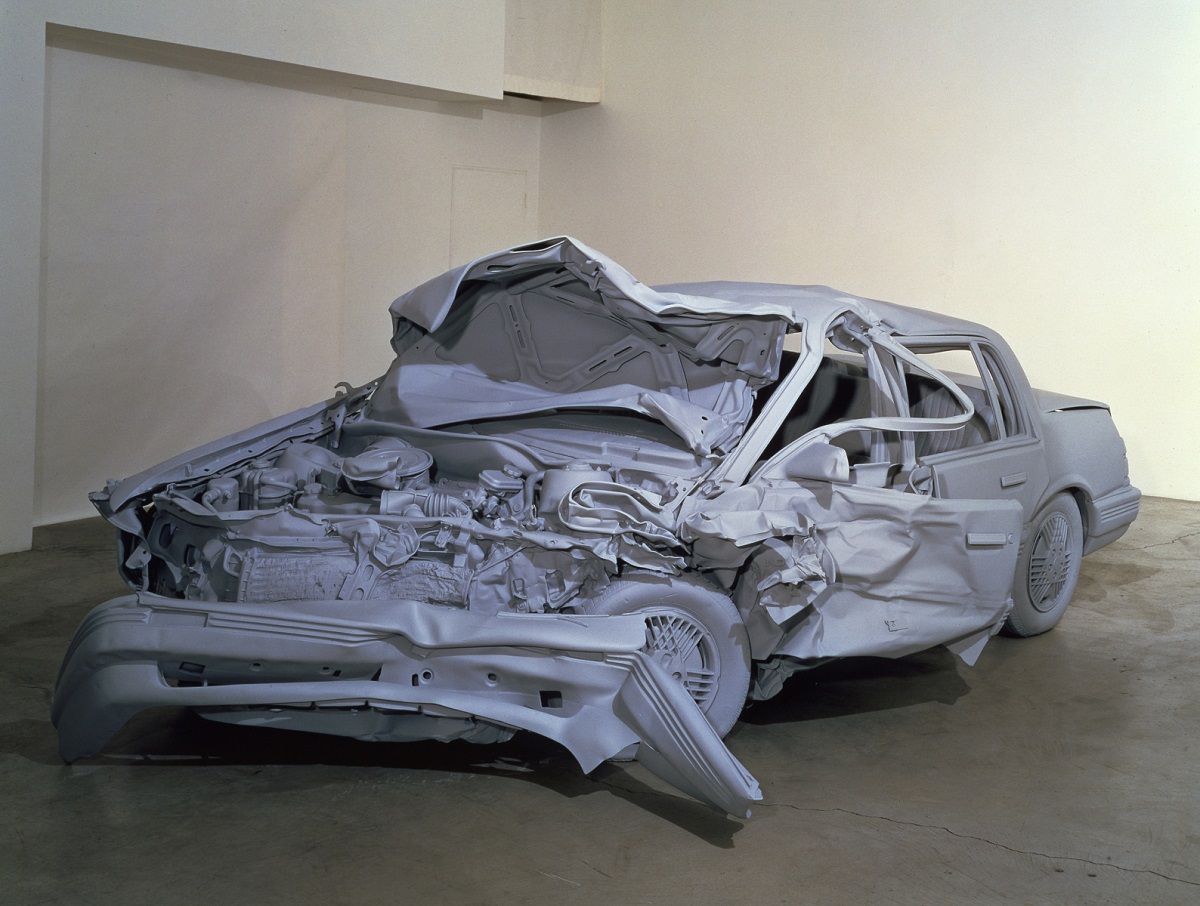

CONTRAPTION PAINTING MACHINE
françois xavier saint-georges
Assembled from chinese brushes and medical equipment, the low-tech automata creates ‘endless line’ ink paintings. Created by canadian designer François Xavier Saint Georges, ‘contraption’ is an autonomous painting machine, capable of creating a ‘never-ending line’ of paint. The low-tech device is composed of medical equipment like syringes and tubing, chinese brushes, and paper with an electric motor, that together continuously run a roll of paper along the wall, to be ‘painted’ upon by ink pumped into the set of brushes. Random variations in the ink’s consistency and viscosity at a given moment produce different effects on the paper, and different colours can be fed into the unit or layered on top of previous ‘paintings’. We will show you more projects from this guy, so if you like it you will see more about him. Enjoy it!
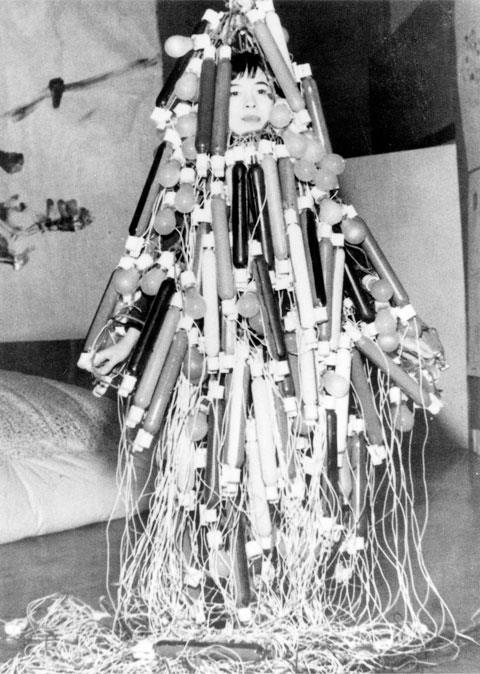
ATSUKO TANAKA
Electric Dress
«‹Electric Dress› is a powerful conflation of the tradition of the Japanese komono with modern industrial technology. Prior to her conception of this work, Tanaka had appeared in a larger than-life paper dress that was peeled away layer by layer, not unlike the peeling away of Murakami’s paintings; she was ultimately disrobed to a leotard fitted with blinking lights. Tanaka began to envision ‹Electric Dress› in 1954, when she outlined in a small notebook a remarkably prophetic connection between electrical wiring and the physiological systems that make up the human body. (…) After fabricating the actual sculpture, she costumed herself in it in the tradition of the Japanese marriage ceremony. Hundreds of light bulbs painted in primary colors lit up along the circulatory and nerve pathways of her body.»
.
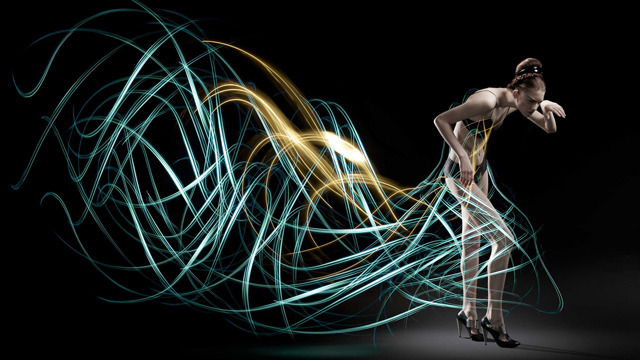
ATTON CONRAD
Light painted trail dresses slide

MICHAEL GUIDETTI
Bounce Room 1
“The digital projection represented as three red, green, and blue spherical lights; and the painted environment as five flat planes receding in perspective. That’s about as far as I could boil them down to. Separately they are elementary and flat, but when they come together, the simulated light and physics of the spheres bouncing around in the space becomes illusionistic.” Michael Guidetti

MARCEL DUCHAMP
مارسيل دوشامب
马塞尔·杜尚
מרסל דושאן
マルセル·デュシャン
Марсель Дюшан
Étant donnés
Duchamp worked secretly on the piece from 1946 to 1966 in his Greenwich Village studio.[2] It is composed of an old wooden door, nails, bricks, brass, aluminium sheet, steel binder clips, velvet, leaves, twigs, a female form made of parchment, hair, glass, plastic clothespins, oil paint, linoleum, an assortment of lights, a landscape composed of hand-painted and photographed elements and an electric motor housed in a cookie tin which rotates a perforated disc. The Brazilian sculptor Maria Martins, Duchamp’s girlfriend from 1946 to 1951, served as the model for the female figure in the piece, and his second wife, Alexina (Teeny), served as the model for the figure’s arm. Duchamp prepared a “Manual of Instructions” in a 4-ring binder explaining and illustrating how to assemble and disassemble the piece.